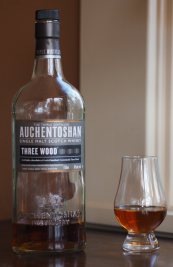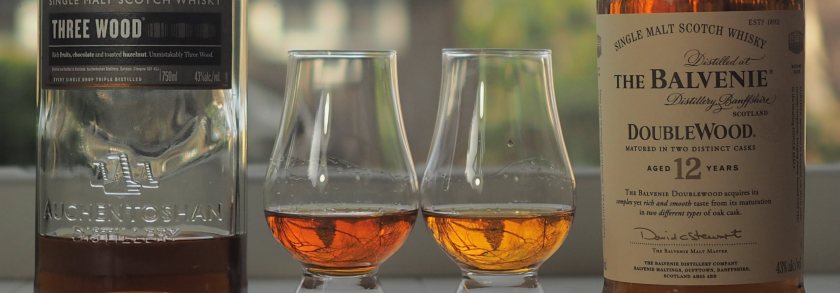
Auchentoshan, uncommon for being a lowland whisky, is also unique for using triple distillation. (Springbank’s Hazelburn line uses the same technique, but no other Scottish distilleries triple-distill routinely.) Triple distillation used to be more common, since with a mix of grains, you should get a smoother whisky with a third distillation. Over time, the rationale has become moot, as single-malt Scotch has been codified to use only barley malt for the grain, so the expensive extra step for a third distillation isn’t seen as necessary. Auchentoshan continues with the practice to produce a light whisky with fewer heavier oils and proteins from the mash. Since the mash uses only unpeated barley, we’re anticipating a delicate flavor.
The Three Wood moniker refers to this expression being aged 10 years in ex-bourbon casks, then finished first for one year in Oloroso sherry casks and finally a 12th year in Pedro Ximenez (PX) sherry casks. There’s not a lot we can say about the casks. There is no specific meaning to cask type, beyond that they once held those types of sherry. As iLaddie states in his excellent study on Oloroso casks “Anyone mentioning “ex-sherry” on their label is basically saying … well … you know … not so much.” The barrels are most likely newly built and ‘seasoned’ with the sherry, not truly ex-sherry solera casks (which typically are used to the point they don’t give much if any flavor to the sherry). Sadly, when asked about their casks, the Suntory rep would not answer: “…we don’t share specific information regarding our formulas or ingredients.” Come on, every distillery I visited in Scotland was happy to tell us about their process, ingredients, and casks. Including Laphroaig (a Suntory company)!

Founded in the 1820s, Auchentoshan has been a Suntory brand since 1994. They introduced the Three Wood in 2002, adding to the existing 12, 18 and 21-year expressions. I use a ‘valiant contender’ approach to analyzing whiskies on this blog, and for the Three Wood, I have as a comparison another unpeated, sherry-finished whisky, Balvenie Doublewood. That’s a bit apples to oranges as the Balvenie uses a single type of sherry cask (Oloroso, less sweet than PX) and is double distilled. The Balvenie distillery is also a lot larger than Auchentoshan, with 11 stills to Auchentoshan’s three and about triple the annual output.
On the the flavor. The Auchentoshan has a rich, balanced nose: the sherry finish is very evident. There is a backing of grain, sweet malt, mineral and a distinct note of cooked cabbage, oddly enough (a little sulfur). In contrast, the Balvenie is a lighter and cleaner nose, sporting an overt honey sweetness (‘toffee’ to my nose when I first tried it some years back).

On the palate, the Three Wood has a nice balance of golden syrup and fairly spicy wood (I’d say there are some European oak casks involved). The sherry aroma is aromatic and deep. It has a nice mouthfeel; I get some white chocolate (the label claims chocolate and hazelnut) and savory herbs ride with the oak tannins, parsley mostly. The finish is fairly dry, though not astringent, and this is where I get the advertised (dark) chocolate and hazelnut, while the herbs hang on as well. The challenger here, Balvenie Doublewood, has a thinner, livelier mouthfeel (though quite good) and lighter flavors. The tannins in the Balvenie are not as pronounced, and the finish more subtle in comparison. Since the Balvenie has only nine months of finishing in Oloroso casks, the sherry influence is not as strong as in the 3 Wood. The Three Wood is a sherry bomb, the Balvenie is more balanced.
Auchentoshan Three Wood, Lowland Single Malt Scotch, 43% ABV
Nose: Lots of sherry, grain, sweet malt, mineral and a distinct note of cooked cabbage.
Palate: Golden syrup, spicy wood, solid tannins to balance the sweetness; savory herbs and finally white chocolate toward the end, giving it a nice mouthfeel.
Finish: Dry and tannic but not over bitter. Dark chocolate, hazelnuts, and sherry lingers. Good balance.
Bottom Line: at $88, I expected the Auchentoshan to be impressive—that price lies in territory held by really good whiskies like Aberlour A’Bunadh ($85) and Glenfarclas 17-year ($100). Although I disagree with my Scotch-loving wife, who prefers the Balvenie, I think the Auchentoshan is a more full-flavored whisky, and it should be, considering its 150% premium in cost over the Balvenie. But the A’Bunadh is seriously kickass stuff and the Glenfarclas 17 is head and shoulders above the Three Wood on account of its luxurious mouthfeel and delightful complex oak character. Given the competition, bottom line for the Auchentoshan Three Wood will land solidly on personal preference. For me, the odd notes on the nose are a bit off-putting, and while the complexity is decent and the mouthfeel is good, the finish is solid but not amazing. There are too many competitors in this price range to say, “just do it.”



Thank you for the mention! Highly appreciated!!! I may have to, finally, look in to auchentoshan
LikeLiked by 1 person
Hi iLaddie, you are quite welcome. Your site is my go-to for nerdy info. I hope you keep up the good work.
LikeLiked by 1 person
Absolutely!!
LikeLiked by 1 person